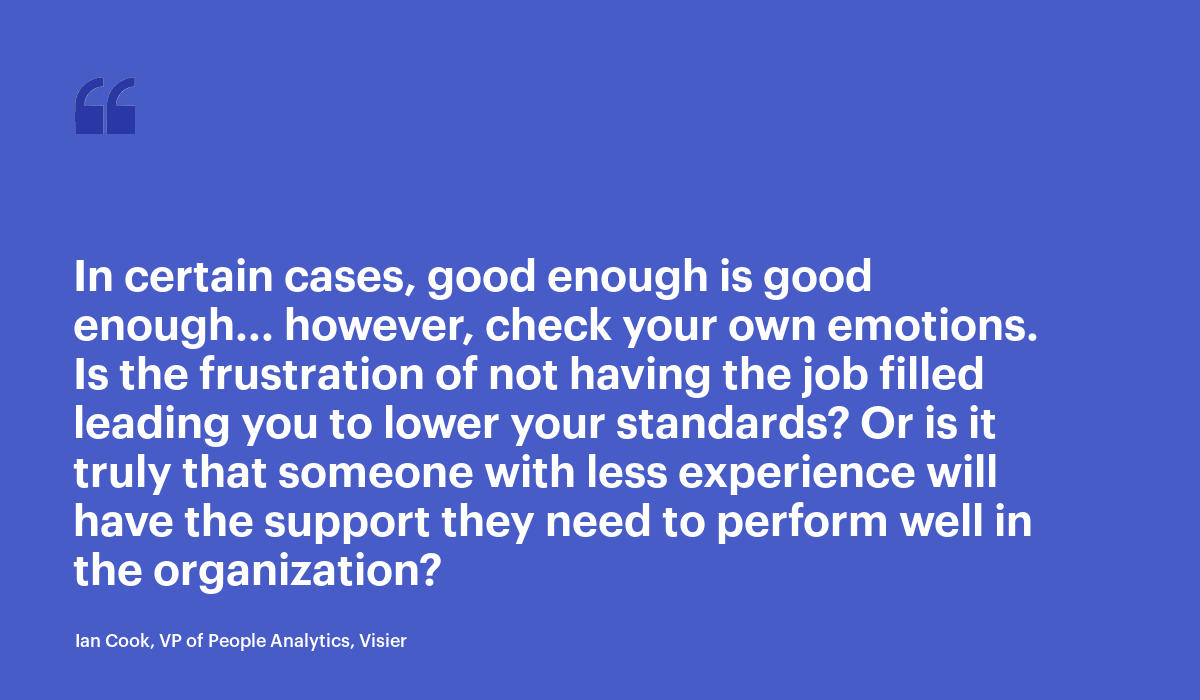How to Keep Your Cool in a Hot Talent Market: Q&A With Visier’s Ian Cook
Employers across the US are struggling to fill open positions. Here are tips hiring managers can use to stay calm under pressure and land the right hires.

Five minutes. That’s how long it takes most hiring professionals to make a decision about a candidate during an interview, according to SHRM. But this kind of go-with-your-gut approach can lead to a host of problems, like inequity or favoring style over substance.
Taking a more analytical path to hiring without slowing down the process is tricky, but it’s something every manager needs to think about these days. People have been quitting their jobs at unprecedented rates, and the ratio of job openings to hires has also reached historic highs in the US. The pressure is on to fill those roles.
I had a chat with Ian Cook, Visier’s VP of People Analytics, to uncover some practical tips for hiring in a hurry. He had a lot to say about the merits of using a structured process, and why you shouldn’t always hold out for the purple squirrel of your field.
Q: The ratio of job openings to hires has reached its highest level in history. What does that mean for managers?
Ian Cook: If you are hiring right now, you can expect that every candidate you talk to will be going through multiple interview streams simultaneously. If that candidate gets another offer anywhere on their hiring journey with you, they may accept that offer and step out of your stream.
This means that hiring managers need to respond very quickly to land the candidates they want. So you can assume that if you are going to do things like take four days to review resumes, that half the people you have reviewed will have moved on by the time you are ready to ask your recruiter to follow up.
Q: How do you make good hiring decisions when the pressure is on like that?
IC: I’m a big advocate for using some kind of measured output to make the judgment. Sometimes hiring managers rely purely on interviews to make their hiring decisions, and if there is no scoring mechanism involved, they end up in a limbo state when the time comes to make a decision.
Make sure you’ve done the work upfront so you can take an analytical approach. Think about your requirements, your must-haves, and which things are irrelevant. Do I test these things through an interview, work practice, or a portfolio? At Visier, for example, when we hire developers, they all go through an online coding assessment called Codility–it’s a test of coding skills that generates a score.
Going through some kind of structured process allows you to do several things. First, you understand the path you are going to follow, then you can communicate that to the candidate so they know what to expect. Secondly, you’re taking the process away from gut instinct. My perspective is that if you have a tight process upfront, and you run people through the process, then you can make a more objective decision quickly.
Q: The current state of the labor market represents multiple things happening at once. How do hiring demands vary by industry?
IC: For a lot of people in the hourly paid workforce, the high vacancy rates are fundamentally about working conditions and pay. Here, filling open positions is about finding ways to boost wages. Some organizations are implementing signing bonuses, which can be a good tactic for getting people in the door, but employers also have to make it worth the candidate’s while to stay. This is where paying some of the signing bonus on day one and the rest after 60-90 days of service can be a more effective strategy. That gives the organization the opportunity to attract that person to the job, and then build a relationship with that person, connect them with the team, and connect them with the work.
For professional jobs, like tech and marketing, the biggest consideration is that remote work has both increased the potential size of the talent pool and constrained it in new ways. In the past, employers only struggled if competition was tight in their geography. Now that’s gone. There is a sufficient number of organizations that are enabling remote and hybrid work, so you have to rethink how you are going to compete. Your local salary band may be an irrelevant factor. Think of the people who have left San Francisco, for example, to earn the same salary in more affordable towns. As a manager, you can’t just go and change the salary band, but if you see you are losing people to remote work, you need to engage your HR team about issues like pay.

Q: Should managers hold out for the very best talent or lower their expectations in the current labor market?
IC: In certain cases, good enough is good enough. You can’t fill every hockey team with Sidney Crosbys or every orchestra with Sarah Changs. If you decide to lower your expectations, however, check your own emotions. Is the frustration of not having the job filled leading you to lower your standards? Or is it truly that someone with less experience will have the support they need to perform well in the organization?
Being conscious about checking your own bias and knowing where you can get by with good enough and where you need that top talent is key. Know what level of proficiency you are aiming for and evaluate skills using tactics like testing during the interview.
Q: What about things like affinity bias? How do you hold that in check when you have a position to fill?
IC: The affinity bias (hiring people who are like you) is what led to Silicon Valley’s bro culture—it’s definitely something to avoid.
My advice is to set up an objective process through candidate testing, and get a relationship going with a recruiter who can provide a good sanity check. I once worked with an HR business partner who was really engaged in the recruiting cycle and he was really good at providing an alternative perspective, asking things like, would you still hire this person if this or that was different? An individual who can ask those counterview questions is really key to supporting a good process.
Q: Indeed, hiring is a team effort. What else should managers be asking of their HR people right now?
IC: It’s challenging because it’s a collaborative venture. A hiring manager might say, “I need to fill this dev role in fifteen days,” but where does that number come from when the last hire took sixty? They then tell you that they have a friend who filled the same kind of role in fifteen days, and the conversation continues to go back and forth.
But with modern technology, talent acquisition teams can use data to forecast when many jobs will be filled based on real-time information. For most positions, it is possible to generate a current understanding of how long it might take to fill. Look for that from your talent acquisition group. Everyone benefits from a good data-driven approach to hiring that is not based on the intuition of your recruiter, but is driven by the data that is available about the market and the current state of affairs.
This way, if the hiring is not happening fast enough, the manager can engage the recruiter in a fact-based conversation about solutions. They can explore things like upping the referral bonus, putting in signing bonuses, going out to external talent agencies who often have go-to people in their books, or even hiring internally. With the right data, recruiters and managers can approach the challenge from a place of curiosity.


